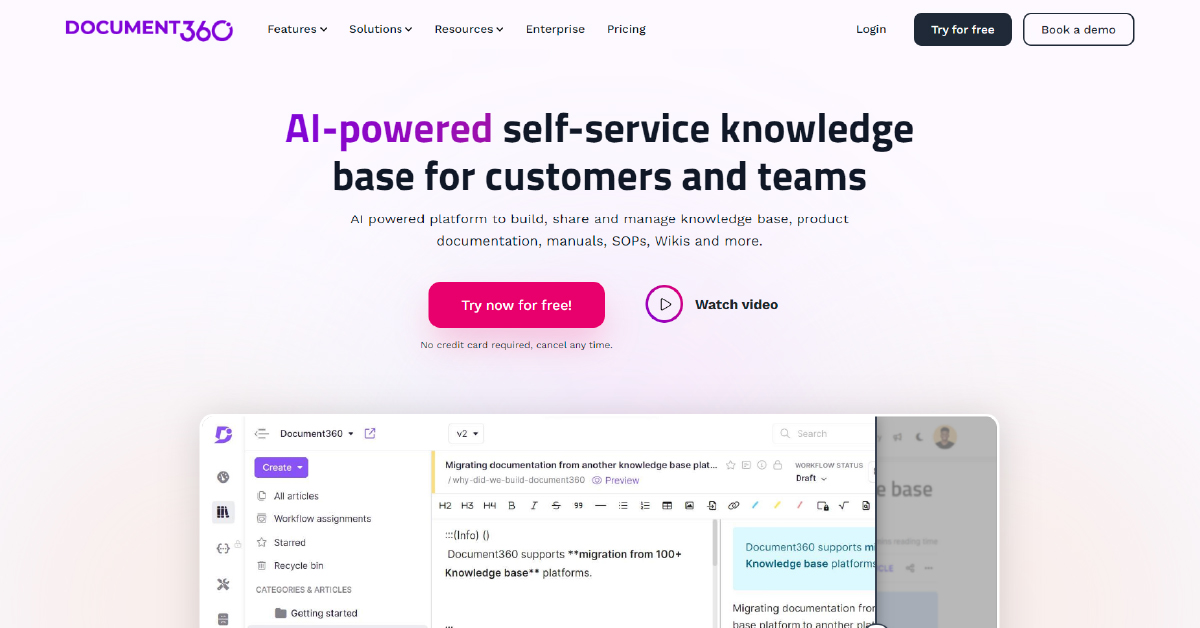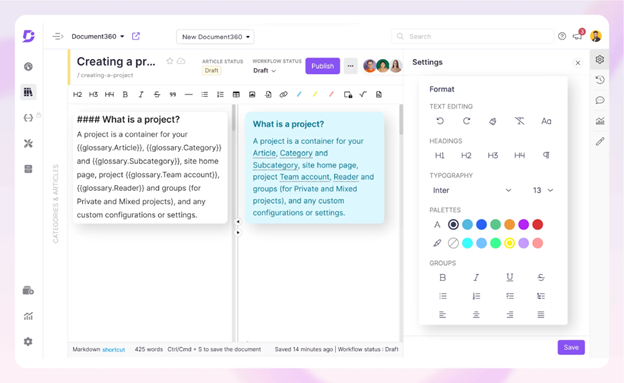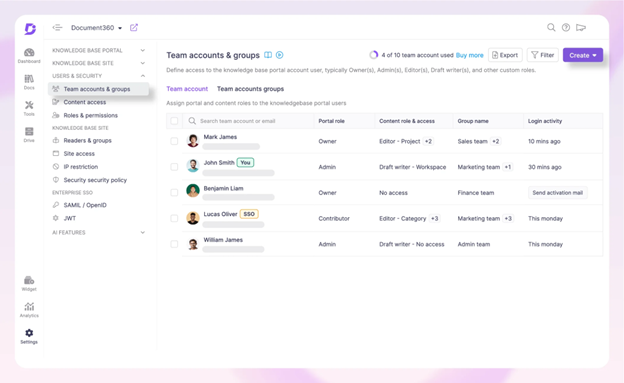Do you want to build shared documentation to keep your product team on the same page about all the features and the tests you’ve run previously?
Build a test specification document now!
But, what is a test specification document?
Test specification documents are the new roadmaps or walk-through guides that help you understand the aspects tested in your product and which approach was used to carry out the tests.
This document acts like a recipe book, documenting all the hits and misses during the trial period. But unlike recipe books, test specification documents enable you to update new information every time you run a new test on your product, along with its results.
In this short yet explanatory guide, we aim to explore the role of a test specification document, its best practices, and tips on writing a compelling document. So, let’s dive in!
Role of Test Specification Document
Given its ability to be a roadmap for product development teams, we can already understand its role in assisting them in building a better product for your organization. There are seven types of commonly used test specification documents:
- Test Case
- Test Plan
- Test Scenario
- Test report
- Checklist
- Bug report
- Requirements
However, let’s explore other roles a test specification document can play and how it benefits all below.
1. Acts as a blueprint for test automation
The test specification document is a blueprint that assists developers and product teams in ensuring consistency and efficiency in the automation process, saving time and reducing errors. It outlines detailed information about testing requirements, implementation approaches, possible outcomes, and more.
2. Eliminates the confusion in the testing phase
A test specification document works towards eliminating any confusion in the testing phase regarding a test approach and its results. This helps you keep everyone on the same track. It reduces doubts in the testing phase by helping you clearly define factors like:
- The objective of running the test
- The procedure you plan to adopt
- The number of errors encountered and their possible solutions
- The outcomes of each test
In a nutshell, it becomes a single source of truth for testers, developers, and stakeholders, ensuring everyone understands what aspects of the product are being tested and how.
3. Prevents taking up more resources than it needs
Using a well-defined test specification document, your team can avoid unnecessary resource allocation errors hassle-free.
This document clearly outlines the test scope and requirements, preventing over- or under-testing the product. This approach lets you understand whether your team’s time, human resources, and various tools are used wisely and efficiently while keeping the testing process lean and cost-effective.
4. Facilitate maintenance and updates throughout the testing lifecycle
Finally, one of the most important roles of test specification documents is to help you evolve the current documentation during the product testing lifecycle. While testing the product, you can update multiple test cases, track previous product changes, and even cover their results.
This ability makes it easier for your team to respond better to bug fixes and ensures your customers get to use a product with fewer errors.
Also Read: Product Requirements Document: Benefits, Tips & Examples
Best Practices for Creating Test Specification Documents
Given its crucial role, any business must build its test specification document immediately. We’ve listed a few best practices to help you get started.
1. Centralizing documentation in a knowledge base
One of the first steps you need to take is to consolidate and organize all the product testing information in one place that is accessible to your teams. If you’ve been using a Word document or updating product upgrade information in Excel or PDF all this time, we suggest you switch to the best knowledge-based solution.
A knowledge base tool will allow you to add all the testing information in one place. That’s not all. You can even track its previous revisions and which developer worked on them to help you understand who carried out the tests and with which team.
Tools like Document360 allow you to:

- Add new articles for every test you conduct on the product. This way, you can separate the information for all the tests.
- Create categories for various tests and store the articles under each category based on the test versions your team conducts.
- Add test videos to help the other members understand what went right, which testing approach was used, and their outcomes.
- Create an internal user manual that your team can only access whenever they want.
- The AI-powered search feature helps you save time and frustration in finding the right piece of information from the huge pile of documentation. This helps you understand what went wrong and possible solutions regarding a specific testing approach.
- Import your existing articles from formats like Word Docs and split them if necessary. Bulk exports to PDF are also available; you can download articles or entire categories as PDFs.
- Add a code block for developers to understand which code went wrong and which the product is currently running on.
- You can get notifications on selected articles or categories that you wish to follow for any new updates.
These crucial features of a knowledge base system like Document360 allow you to gather all the information in one place and create a knowledge inventory for your employees.
2. Keep your specification document under version control
When using a knowledge base tool, you can easily ensure that your test specification articles do not lose the previous version of the document.

Features like a difference viewer enable you to read the article’s previous and new versions side by side. This allows you to track:
- The changes that took place in the document
- The solutions that got changed due to the change in testing approach
- The team members who worked on the previous and new article versions
This functionality also allows you to reverse the changes and return the article to its original version.
3. Ensuring the security of sensitive information
Want only selected people in the organization to gain access to your test specification document?
There are multiple ways of doing so if you plan to adopt a knowledge-based solution for your team. Some of these approaches include:
- Add Team Roles:
You can grant user access to probably multiple employees, but only a few can gain admin access and make changes to the document. You can add roles like contributors for technical writers who are writing new articles. You can even add an editor role for developers and product team managers to review and edit articles once they are completed by the writers.

- Create Private Documentation
Certain users can only access this with login credentials. This is one of the best ways to limit documentation access to limited people in the company and ensure it’s in good hands. You can also send private links to others to access a particular document.
- Enable IP Restriction
Another way to secure your test specification documents is to enable IP restriction features in your knowledge base. This will enable employees with certain IP addresses to access the documentation, therefore avoiding any breach with the current testing information.
These features will help you keep information on product testing, allow your team to respond better to bug fixes ensure your customers are safe, and offer access to those closely related to the process.
4. Regularly pruning irrelevant documents
If you feel that one of your pieces of content is outdated or your team no longer conducts certain testing methodologies, you can remove or archive that article.
This is a great way to ensure that your specification document is updated regularly and that team members find no irrelevant testing information. Doing so helps your team save time and act on reasonable approaches only.
5. Maintaining consistency with a style guide
Building a style guide is essential for your test specification document. This allows you to publish the articles under each testing category in a certain format, making it easier for developers to access and understand the information hassle-free.
You can set up an article template for your technical writing team. They can add information according to the template, avoiding any instances of missing crucial information on the testing approach and its results.
Schedule a demo with one of our experts to take a deeper dive into Document360
Book A Demo
Tips for Writing Compelling Test Specification Documents
To accelerate your writing process for the test specification document, our team has listed some tips for writing the articles. These include the following:
1. Utilize present tense and concise language for clarity
Be direct when writing information on product testing. Just like product documentation, your articles on product testing can include steps. These steps can be about how to execute a certain test methodology, analyze its results, and share the results with the team. What’s more, it would help the readers if your content is written in the present tense. Here’s an example to help you out:
Test Specification: AI-Powered Live Chat Feature
Objective: Verify the functionality and performance of the AI-powered live chat feature.
Test Case 1: AI Response Accuracy
Step 1: Open the live chat window.
Step 2: Type “How do I reset my password?”
Step 3: Verify that the AI provides a clear, accurate response with steps to reset the password.
Step 4: Check that the response is given within 5 seconds.
This will help the testing team understand the objective for which a feature was tested and the outcomes of this test.
2. Use a standardized format for the test specification document
If you already have a template, your technical writing team would find it useful. It will set a standard format for these articles.
When creating a template for your test specification articles, you can add the following components:
- Test Objectives
- Scope of Testing
- Test Environment
- Hardware requirements
- Software requirements
- Network configuration
- Test Cases
- Test Data
- Entry and Exit Criteria
- Test Deliverables
- Roles and Responsibilities
- Risk Assessment
- Test Schedule
These will help them include the right information about the test conducted, and the team will find all the relevant information about a test in one place.
3. Choose the appropriate level of detail based on the target audience
If you plan to target your internal team directly involved with the testing process, it would be great if you could offer detailed information on the test and its results.
This is a tricky situation as sometimes the sales team also accesses the information to inform prospects of previous changes and how a particular feature works after changes. Therefore, readers need to be introduced to the language and the level of detail in the article appropriately.
4. Add comments or annotations when needed
Finally, don’t forget to add comments for content improvement or annotations to explain certain technical terms to the readers. This is a great way to ensure that your content gets accessed with a better understanding of the technical terms and that the right information is passed to those with access to the documentation.
Also Read: Software Requirements Document (SRD): Benefits & Examples
Start Building Your Test Specification Document Now!
A test specification document is a much-needed blueprint around your product testing activities that your internal team needs. It helps you track all the tests done on the product, the results achieved, and the better solutions found during the process. It even allows you to track the resources used during the testing phase and help you decide whether the same number of resources will be needed in the future.
Given its ability, no doubt building your document becomes a must. To build yours from scratch, it is important that you onboard the best knowledge base software, like Document360, which helps you build a centralized repository of information for employees.





 –
– 

